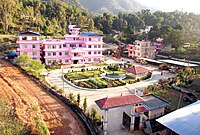
Photo from wikipedia
Environmental flow assessments (e-flows) are relatively new practices, especially in developing countries such as Nepal. This study presents a comprehensive analysis of the influence of hydrologically based e-flow methods in… Click to show full abstract
Environmental flow assessments (e-flows) are relatively new practices, especially in developing countries such as Nepal. This study presents a comprehensive analysis of the influence of hydrologically based e-flow methods in the natural flow regime. The study used different hydrological-based methods, namely, the Global Environmental Flow Calculator, the Tennant method, the flow duration curve method, the dynamic method, the mean annual flow method, and the annual distribution method to allocate e-flows in the Kaligandaki River. The most common practice for setting e-flows consists of allocating a specific percentage of mean annual flow or portion of flow derived from specific percentiles of the flow duration curve. However, e-flow releases should mimic the river’s intra-annual variability to meet the specific ecological function at different river trophic levels and in different periods over a year covering biotas life stages. The suitability of the methods was analyzed using the Indicators of Hydrological Alterations and e-flows components. The annual distribution method and the 30%Q-D (30% of daily discharge) methods showed a low alteration at the five global indexes for each group of Indicators of Hydrological Alterations and e-flows components, which allowed us to conclude that these methods are superior to the other methods. Hence, the study results concluded that 30%Q-D and annual distribution methods are more suitable for the e-flows implementation to meet the riverine ecosystem’s annual dynamic demand to maintain the river’s health. This case study can be used as a guideline to allocate e-flows in the Kaligandaki River, particularly for small hydropower plants.
Journal Title: Sustainability
Year Published: 2020
Link to full text (if available)
Share on Social Media: Sign Up to like & get
recommendations!